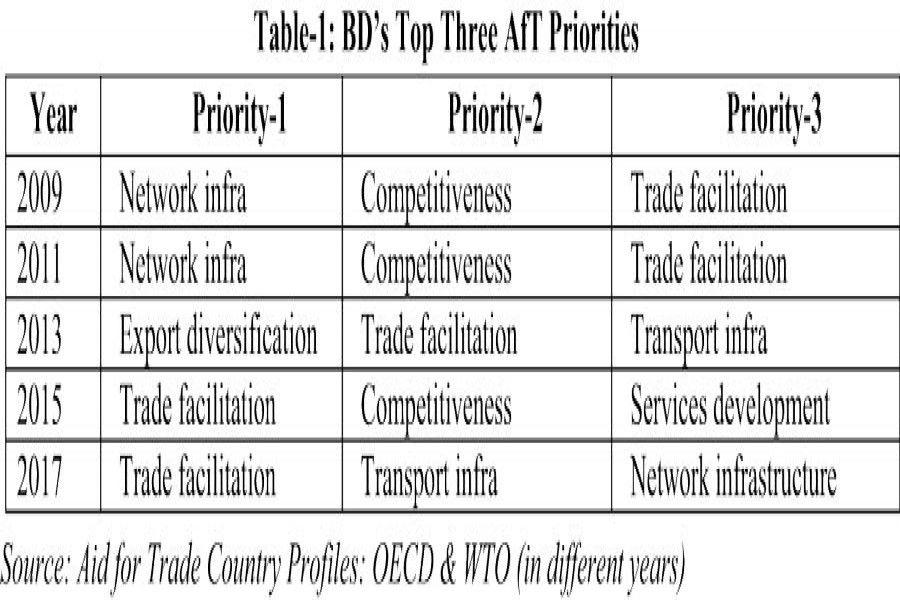Enhancing trade and developing trade related capacity and infrastructure in developing and Least Developed Countries (LDCs) is a lingering challenge most of these countries are critically fraught with. To overcome the challenge, trade-related aid is recognised as an important tool by the international community. That's why, the Aid for Trade (AfT) programme was approved in 2005 at the Hong Kong Ministerial Conference of the World Trade Organisation (WTO). In February 2006, the WTO established a task force to operationalise the AfT. Although more than a decade has passed, effectiveness of the programme is not much visible.
Against the backdrop, members of the World Trade Organisation (WTO) gathered in Geneva during the first week of this month to examine the status of the AfT programme. It was the 'Seventh Global Review of Aid for Trade' under the theme 'Supporting Economic Diversification and Empowerment for Inclusive, Sustainable Development through Aid for Trade.' Review report titled 'Aid for Trade: At a Glance 2019' and a few other related publications were unveiled during the event.
The review report, jointly prepared by Organisation of Economic Co-operation and Development (OECD) and WTO, showed that since the inception of the programme, 'more than US$ 409 billion' has been disbursed under the AfT, 'reaching 146 countries or territories' to help them build their trade infrastructure and capacity. It also mentioned that more than 178,000 AfT projects have been funded since 2006.
Generally, the biennial review report is considered as a detailed documentation of the AfT status. It provides elaborate statistics and some analyses of AfT and its impact. The meeting accepted the report as 'final review' and the concern raised by many developing countries on the limitation of the review mechanism was not accommodated.
The three-day event concluded with the high hope that the AfT would contribute more in near future. At the end of the day, the WTO and its partner organisations like OECD tried to portray a rosy picture of the AfT.
Nevertheless, some questions and concerns regarding the long-term effectiveness of the programme remained unanswered. The three-day biennial event, packed with more than 80 sessions of workshops and discussions, brought many issues overlooking the critical focus on AfT. Due to the wide range of the meeting agenda, it became difficult to assess the overall outcome of the event. The thematic sessions, however, tried to examine the impact of AfT.
A number of representatives of the LDCs argued that AfT needed to 'adopt evolving needs' of these countries. They also stressed on 'continued support even as they graduate to a higher economic status.' This indicated that LDCs found the AfT inadequate and to some extent distorted.
The review report mentioned that AfT is unevenly distributed among the LDCs. The top five recipients - Afghanistan, Bangladesh, Ethiopia, Mozambique, Tanzania - account for over 40 per cent of total AfT disbursed to the LDCs between 2006 and 2017. This, however, largely depends on socio-economic condition of the countries. For example, being a war-torn country, Afghanistan has received a very big amount of foreign aid for rebuilding and reconstruction of physical infrastructures. A portion of such aid was labelled as AfT. For Bangladesh, it is the growing size of the economy that mattered.
BANGLADESH CONTEXT: In 2017, Bangladesh received $1.89 billion aid for trade against the annual commitment of $2.96 billion. Statistics showed that disbursement of fund increased gradually in the last 10 years while commitment from donors fluctuated regularly. In 2017, country's top three priorities for AfT were trade facilitation, transport infrastructure and networking infrastructure. Two years back in 2015, these were trade facilitation, international competitiveness and services development. Over the years, there are small changes in these priorities as presented in Table-1. It shows that trade facilitation is always a top priority. Competitiveness and infrastructure are also in the list most of the time. Only export diversification was a top priority in 2013. Though the country's export basket is yet to be diversified and there is always a call for diversification, little advancement is there in this regard. Slipping from the top priority indicates that the country's trade strategy has less emphasis on export diversification.
Nevertheless, Bangladesh along with Cambodia and Myanmar are the three most diversified merchandise exporting LDCs. On an average, LDC exports reach 46 foreign markets whereas merchandise exports of Bangladesh go to 106 markets-- the highest among the LDCs. Moreover, three LDCs (Angola, Bangladesh and Myanmar) also account for over half of the LDC share of merchandise exports. Again, most LDCs export some 17 categories of services, while Senegal and Bangladesh recorded the highest level of services diversification, exporting in 35 and 33 categories in 2017 respectively.
The impact of AfT in Bangladesh appears limited. In some cases, committed or disbursed aid for other purposes was linked with trade related activities and labelled as aid for trade. So, there is a 'grey area' in the whole process of the AfT. A number of donors try to convert their existing aid into trade-related aid. Thus, all these aid, received by Bangladesh and other LDCs as AfT, are actually not aid to directly and exclusively facilitate trade. The whole process is non-transparent to some extent.


